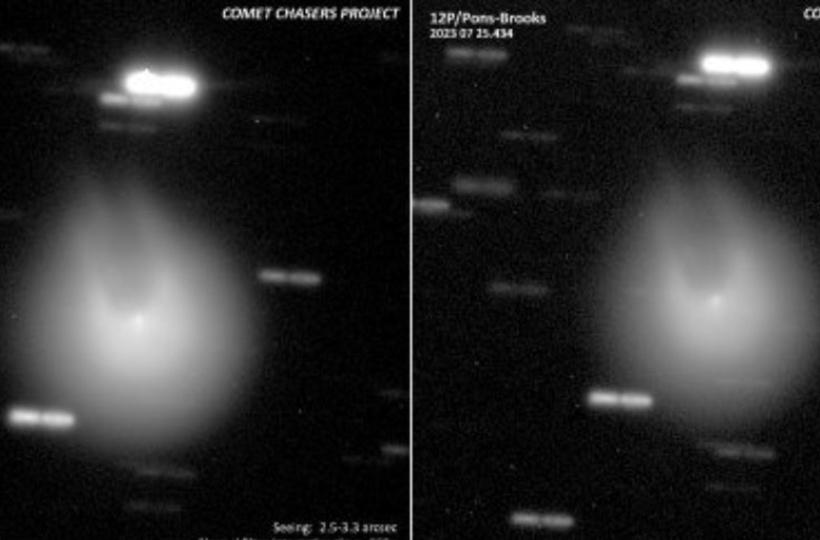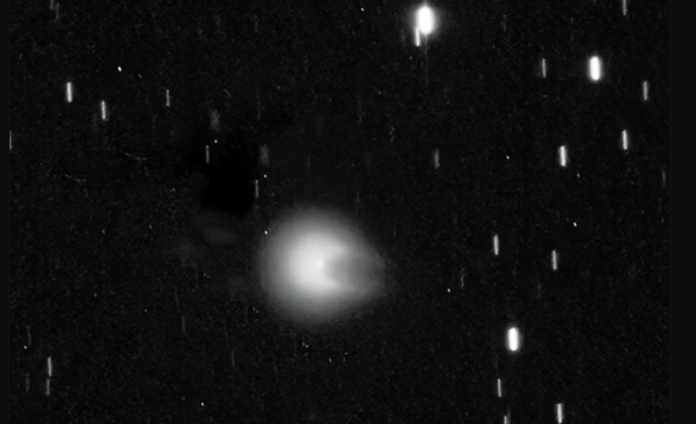A comet known as the “devil comet” because of its two distinct “horns” made of gas and ice. It is now traveling through the inner solar system at a high pace and may be seen with the unaided eye in the spring when it gets closest to Earth.
This astronomical body, officially named Comet 12/P Pons-Brooks, is not dangerous to Earth. Rather, when the comet approaches Earth on its 71-year journey around the sun, skywatchers will have the chance to attempt and locate the cosmic invader.
SOURCE : NBC NEWS
April 21, 2024, is when comet 12/P Pons-Brooks will approach perihelion or the point in its orbit closest to the sun. The comet will come closest to Earth on June 2, not too long after that. Astronomers have said that at that period, if the sky is sufficiently dark and clear, the comet may be visible to the unaided eye.

Meanwhile, enthusiasts with large telescopes have been enjoying a display from Comet 12/P Pons-Brooks.
Twice in the last four months, astronomers have seen the comet erupt: once in July and once earlier this month.
The comet brightened dramatically during both outbursts, releasing clouds of gas and frozen debris that resembled two matching horns. Some compared the comet’s unusual look after its explosion to that of the “Star Wars” spaceship Millennium Falcon.
Using two remote telescopes in Utah, amateur astronomer Eliot Herman, a retired professor at the University of Arizona’s School of Plant Sciences, was able to take some amazing pictures of Comet 12/P Pons-Brooks with its devil horns.
The comet is composed of an ice, gas, and dust core that is encircled by a luminous gas cloud called a coma. Heat from the sun and solar radiation may cause dramatic outbursts like the ones that were seen in October and July in the comet’s core.

Herman noted that these ice outbursts are likely to be the source of the comet’s transient horns. The structure of the comet could be influencing how the gas and ice ejected clouds look from Earth, giving ground-based observatories the impression of horns.
Herman claims that our understanding of the specifics of what is occurring is lacking.
He sent an email to NBC News saying, “There is a community of observers who are studying this, and by observing this more intensely we might resolve this question.”
1812 saw the discovery of Comet 12/P Pons-Brooks by Jean-Louis Pons, a French astronomer. The object was reobserved by astronomer William Brooks in 1883. The comet won’t make another near pass to the inner solar system for 71 years after its close encounter in the spring.
As Comet 12/P Pons-Brooks approaches Earth and before it round the sun and veers back into the outer solar system, astronomers are eager to see and analyze it.
Its approach time on April 8, 2024, coincides with a complete solar eclipse. Comet 12/P Pons-Brooks will be near the sun and probably bright enough to observe with the unaided eye at that time, according to Herman.
“Many comets pass close to the sun each year in images taken by the NASA SOHO space probe, but it is impossible to see one with the naked eye unless there is an eclipse, which there will be,” he added. “I hope to see and photograph it while I’m in Texas.”
The marvels of the cosmos never cease to astound us. Astronomers and sky watchers alike are set for a treat this summer as a unique and fascinating guest from deep space makes its approach towards Earth. This heavenly explorer, known by the nickname “Devil Comet” because to its unusual appearance, is scheduled to pass near Earth, providing an incredible cosmic show.
The Devil Comet’s Arrival
The Devil Comet, officially designated as 666P/Perihelion in science, is not your typical comet. Its tail resembles a pair of demonic horns, which is how it got its moniker. The Devil Comet has a peculiar horn-like appearance due to its two separate streams of tail material, unlike other comets that typically have a lengthy tail from the outgassing of volatile components as they approach the Sun.
The comet is a celestial wonder for scientists and stargazers alike because of its unusual composition and rotation, which is the main cause of this uncommon occurrence. We get to see the cosmic craftsmanship of nature, which is a sight that inspires both amazement and curiosity.
The Journey of the Devil Comet
Astronomers and skywatchers have always been captivated by comets, such as the Devil Comet. These frozen bodies, which are found in the Oort Cloud and Kuiper Belt, are from the outermost regions of our solar system. They are periodically forced into orbits that bring them closer to the Sun by their gravitational interactions with planets like Jupiter.
This summer, the Devil Comet’s voyage will bring it quite near to Earth, enabling us to see its majesty. Its closest approach to the Sun, or perihelion, is scheduled for mid-July, which makes it an ideal opportunity to see the celestial show. Scientists will have a rare chance to examine the makeup and behavior of the comet thanks to this near approach.
What to Anticipate
The Devil Comet will become brighter in the night sky as it gets closer to the Sun and could perhaps be seen with the unaided eye. When the sky are at their darkest, which is either before dawn or after sunset, you should have the finest viewing circumstances. There’s a greater possibility of viewing this celestial display for observers in places with less light pollution.
Investing in a small telescope or binoculars can improve your viewing experience by enabling you to make out the intricate features of the comet’s recognizable horns. The comet will emit gas and dust as its frozen core warms, creating a tail that stretches in two different directions.
In summary
This summer’s “Devil Comet” is expected to be a spectacular sight in the night sky, providing amateur and expert astronomers with a rare chance to see a celestial event that blends science with eye-catching beauty. With its horn-shaped tail soaring past Earth, it serves as a constant reminder of the wonder and enigma of our cosmos.
Put this incredible event on your calendars, set your alarms, and be ready to see it happen. This summer, the “Devil Comet” is expected to rattle the heavens; it’s an event not to be missed. This celestial visitor is guaranteed to make an impact and arouse astonishment at the size of our universe, regardless matter whether you’re an experienced stargazer or simply trying to connect with the cosmos.





